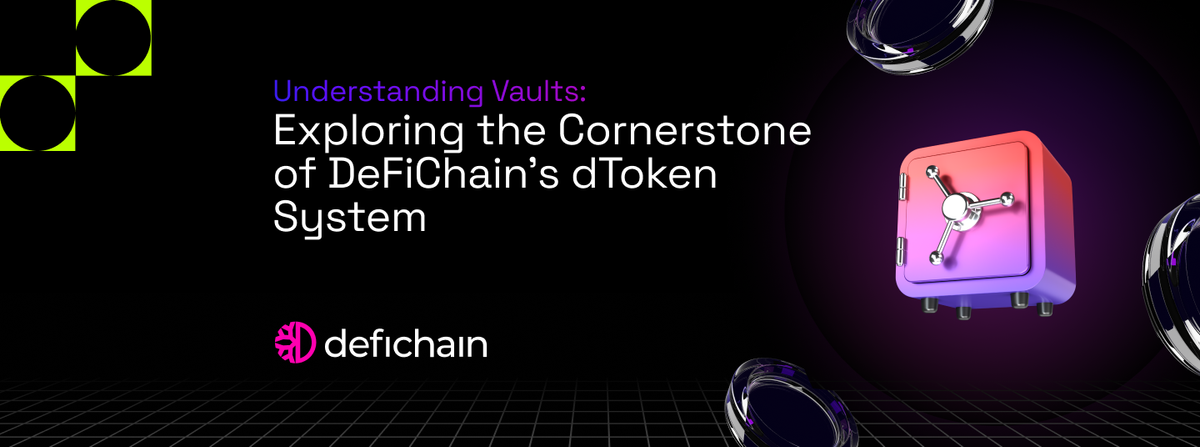
DeFi vaults play a crucial role in the decentralized finance ecosystem, serving a multifaceted purpose beyond traditional safe-deposit boxes. Instead of just safeguarding crypto assets, these smart contracts facilitate various financial activities.
Vaults are used for strategies like yield optimization, such as arbitraging between decentralized exchanges and yield farming by staking governance tokens automatically to compound rewards. On the DeFiChain blockchain, vaults are even more important as they create ‘dTokens’ that represent real-world assets on the decentralized ledger.
This article will explore the mechanics of crypto vaults, explaining how they operate and emphasizing their crucial role within the DeFiChain ecosystem.
What are Crypto Vaults?
Crypto vaults are smart contracts that securely store digital currencies and assets. In DeFi, these vaults have expanded to become automated investment platforms. Users deposit their assets into vaults, which then use predefined strategies to generate yields by investing across various DeFi protocols and blockchains.
For example, yield farming vaults stake users’ funds to earn rewards and interest, compounding their returns by reinvesting earnings into new opportunities. By pooling capital from many users, vaults can create diversified strategies that maximize returns through trading, staking, and rebalancing.
In the DeFiChain ecosystem, vaults enable the creation of “dTokens” – digital representations of real-world assets like stocks or commodities on the blockchain, merging traditional investments with DeFi.
While crypto vaults initially served as storage, they have evolved into sophisticated investment tools that optimize yields and provide access to mainstream assets. This automation makes vaults essential in the decentralized economy.
Understanding Vaults Categorization in DeFi
Categorizing vaults in DeFi can be complex due to differences in strategy, function, and objectives. Two main types are Simple “Crypto” Vaults and Complex “Strategy” Vaults.
Simple “Crypto” Vaults
These vaults focus on securely holding and protecting digital assets, emphasizing security mechanisms and supporting tasks within a larger infrastructure.
They facilitate cross-chain transactions for user deposits, trades, and withdrawals across multiple blockchains.
Complex “Strategy” Vaults
These vaults execute predefined investment strategies to maximize yields by leveraging various DeFi protocols concurrently.
For example, a strategy vault might invest in yield farming and lending platforms, adjusting positions to optimize returns in changing market conditions.
Both simple and complex vaults play crucial roles in DeFi by providing secure custody and actively compounding yields, reflecting diverse functions within the ecosystem.
Use Cases of DeFi Vaults
Lending Vaults
Lending vaults allow users to obtain decentralized loans by minting new tokens on the blockchain, using crypto assets as collateral without extensive background checks.
On DeFiChain, lending vaults create “dTokens” representing real-world assets by depositing collateral, tokenizing traditional assets on the blockchain.
Yield Farming Vaults
These vaults seek out the most profitable farming opportunities, moving assets between protocols to capture high returns autonomously.
Platforms like Yearn Finance pioneered automated yield farming, optimizing earnings by shifting funds across various protocols.
Liquidity Provider (LP) and AMM Vaults
Designed for decentralized exchanges, these vaults automate supplying liquidity to AMM pools, managing asset ratios for optimal liquidity depth and harvesting rewards.
Stablecoin Vaults
Stablecoin vaults focus on fiat-pegged cryptocurrencies like USDC and DAI, generating returns with reduced volatility through lending or yield farming.
Liquidity Mining Vaults
These vaults maximize rewards from liquidity mining programs, incentivizing liquidity provision with bonus token emissions.
Leveraged Yield Farming Vaults
These vaults leverage user deposits with debt to enhance yields from farming strategies, balancing higher risk with potential higher rewards.
Algorithmic Trading Vaults
Using coded algorithms, these vaults execute automated trading strategies like arbitrage and market making to generate profits, potentially hedging risks.
DeFi protocols offer various vault types tailored to specific investment objectives, providing specialized options for diverse needs within the DeFi space.
Associated Risks and Considerations of DeFi Vaults
Despite unlocking opportunities, DeFi vaults come with risks that investors must consider. Due diligence and understanding the technology and market dynamics are crucial in this rapidly evolving ecosystem.
Smart Contract Vulnerabilities
Vaults, like other DeFi protocols, are built on smart contracts that could contain code exploits. DeFiChain’s non Turing complete code minimizes this risk significantly.
Strategy Execution Risks
A vault’s performance relies on its investment strategy. Poorly designed strategies that fail to adapt can underperform and erode returns.
Network congestion and gas fees: Using blockchain vaults incurs gas fees that can spike during high network demand, affecting profits.
Impermanent Loss
Vaults providing liquidity to AMMs face risks of impermanent loss if asset prices diverge after depositing funds.
Liquidation Risk
Using lending vaults poses liquidation risk if locked collateral value falls below the debt value, necessitating caution from users.
DeFi vaults offer innovative capabilities, but also new risks. Investors must manage these risks through audits, strategy vetting, and understanding the underlying mechanics before entrusting capital to automated investment platforms.
Final Words
Crypto vaults have become essential infrastructure in DeFi, powering various use cases from yield optimization to tokenizing real-world assets. In DeFiChain, these vaults balance secure storage with algorithmic investment management, bridging traditional finance with DeFi seamlessly.
However, these innovative capabilities come with unique risks that demand robust risk management. Users must remain vigilant against vulnerabilities, impermanent loss, and other DeFi hazards by diversifying, sizing positions carefully, and understanding the potential of crypto vaults in the decentralized financial landscape.



